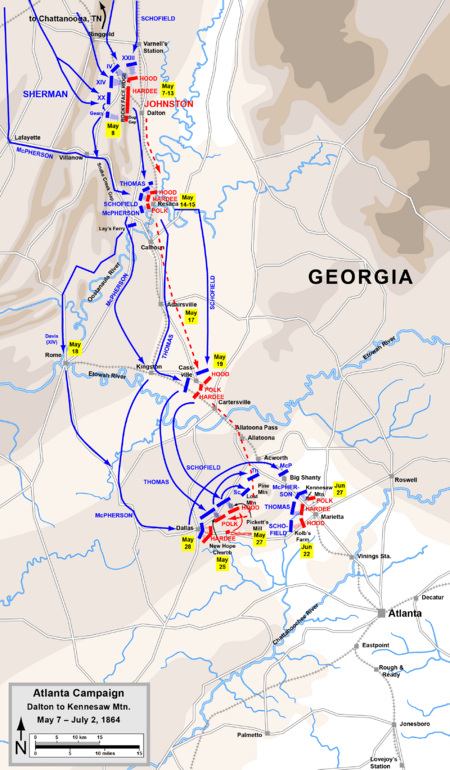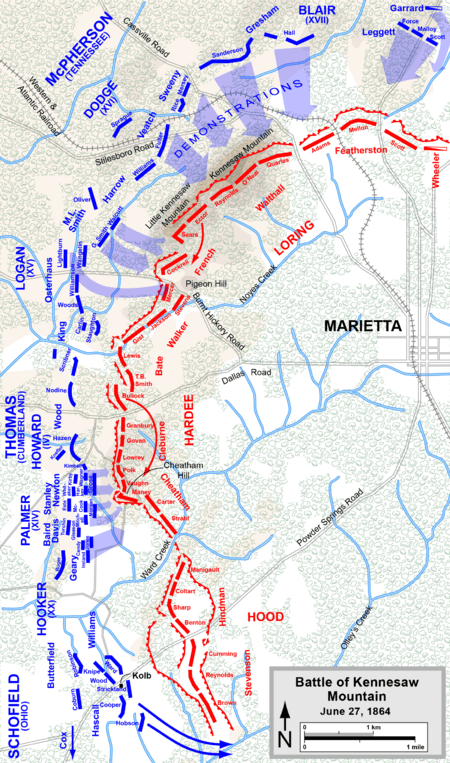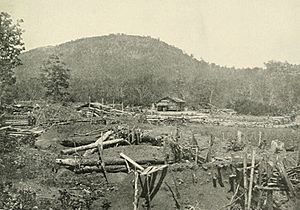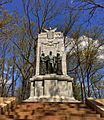Battle of Kennesaw Mountain facts for kids
Quick facts for kids Battle of Kennesaw Mountain |
|||||||
|---|---|---|---|---|---|---|---|
| Part of the American Civil War | |||||||
 "Kennesaw's Bombardment, 64", sketch by war correspondent Alfred Waud, digitally restored |
|||||||
|
|||||||
| Belligerents | |||||||
| Commanders and leaders | |||||||
| William T. Sherman | Joseph E. Johnston | ||||||
| Units involved | |||||||
|
Military Division of the Mississippi: |
Army of Tennessee | ||||||
| Strength | |||||||
| 16,225 | 17,733 | ||||||
| Casualties and losses | |||||||
| 3,000 | 1,000 | ||||||
The Battle of Kennesaw Mountain happened on June 27, 1864. It was part of the Atlanta Campaign during the American Civil War. This battle was a big attack by Union General William Tecumseh Sherman against the Confederate army led by General Joseph E. Johnston. The Union forces lost this battle, meaning it was a tactical defeat for them. However, for the Confederates, it didn't stop Sherman's army from moving closer to Atlanta, Georgia. This was a big problem for the Confederacy.
Sherman's plan to capture Atlanta in 1864 usually involved clever moves around the Confederate army's sides. This forced Johnston's army to leave their strong positions without much fighting. After two months of these moves, Sherman's path was blocked by very strong forts on Kennesaw Mountain. This mountain is near Marietta, Georgia. Sherman decided to try a different plan. He ordered a direct attack on June 27. The Union attacks were pushed back with many losses. But a move by General John Schofield threatened the Confederate army's side. This forced Johnston to retreat again towards Atlanta. Soon after, General Johnston was removed from his command.
Contents
Why the Battle Happened
In March 1864, Ulysses S. Grant became the main general of the Union Army. He planned many attacks at the same time against the Confederacy. His goal was to stop the Confederate armies from helping each other. Two main attacks were planned. General George G. Meade and Grant himself would attack Robert E. Lee's army and move towards Richmond, Virginia, the Confederate capital. General William T. Sherman would lead another attack from Chattanooga, Tennessee, towards Atlanta.
At first, both Grant and Sherman wanted to destroy the main Confederate armies. Capturing cities was a secondary goal. But as the war went on, cities like Richmond and Atlanta became very important. By 1864, Atlanta was a key target. It was a city of 20,000 people. Four important railroad lines met there, bringing supplies to the Confederacy. Atlanta also made military supplies. Its nickname was "Gate City of the South." Taking Atlanta would open up much of the Deep South to the Union. Grant told Sherman to "move against Johnston's Army, to break it up and to get into the interior of the enemy's country as far as you can."
Sherman had about 100,000 soldiers. They were divided into three armies. These were the Army of the Tennessee led by General James B. McPherson, the Army of the Cumberland led by General George H. Thomas, and the smaller Army of the Ohio led by General John M. Schofield. Their main enemy was the Confederate Army of Tennessee. This army was led by General Joseph E. Johnston. He had taken over from Braxton Bragg after a defeat in Chattanooga in November 1863. Johnston's army had about 50,000 men.
The Atlanta Campaign Begins
Sherman's campaign started on May 7. His three armies left the area around Chattanooga. He made small attacks against Johnston's position at Rocky Face Ridge. Meanwhile, McPherson's army secretly moved around Johnston's left side. They headed towards Resaca to cut off Johnston's supply line. But McPherson met a small Confederate force and pulled back. This missed a chance to trap the Confederates.
Sherman then moved his whole army towards Resaca. Johnston pulled back to new positions there. Heavy fighting happened at the Battle of Resaca on May 14–15. But there was no clear winner. Sherman then moved around Johnston's side a second time. He crossed the Oostanaula River. As Johnston retreated again, small fights broke out at Adairsville on May 17. More general fighting happened on Johnston's Cassville line on May 18–19. Johnston planned to defeat part of Sherman's army. But General John Bell Hood became too careful and feared being surrounded. He failed to attack as ordered. Johnston then ordered another retreat, this time across the Etowah River.
Johnston's army took strong defensive spots at Allatoona Pass. But Sherman again moved around Johnston's left side. He left his railroad supply line for a short time and moved towards Dallas. Johnston had to leave his strong position and meet Sherman's army in the open. Fierce but undecided fighting happened on May 25 at New Hope Church, May 27 at Pickett's Mill, and May 28 at Dallas.
By June 1, heavy rains turned the roads into mud. Sherman had to go back to the railroad to get supplies. Johnston's new defense line was set up by June 4. It was northwest of Marietta, along Lost Mountain, Pine Mountain, and Brush Mountain. On June 14, after eleven days of rain, Sherman was ready to move. He saw some Confederate officers on Pine Mountain and ordered his cannons to fire. General Leonidas Polk was killed. Johnston then moved his men from Pine Mountain. He set up a new curved defense line from Kennesaw Mountain to Little Kennesaw Mountain. Hood's corps tried an attack at Peter Kolb's farm on June 22, but it failed.
Sherman was stuck about 15 miles north of Atlanta. He couldn't keep moving around Johnston's side because the roads were too muddy. Also, Johnston's position on Kennesaw Mountain controlled Sherman's railroad supply line. Sherman decided to break this standstill by attacking Johnston's position. He gave orders on June 24 for an attack on June 27 at 8 a.m.
The Battle Itself
Sherman's plan was to make Johnston spread out his soldiers. First, Schofield would move his army to the right. Then, McPherson would pretend to attack on his far left, near Marietta. He would use his cavalry and a division of infantry. McPherson would also make a big attack on the southwest side of Little Kennesaw Mountain. At the same time, Thomas's army would make the main attack. This would be against the Confederate forts in the middle of their line. Schofield would also make a show of force on the Confederate left side. He would attack near Powder Springs Road if it looked like he could win.
At 8 a.m. on June 27, Union cannons fired heavily. Over 200 guns shot at the Confederate forts. The Confederate cannons fired back just as strongly. One officer wrote that "Kennesaw smoked and blazed with fire, a volcano as grand as Etna." As the Union soldiers started moving, the Confederates quickly realized that most of the attacks were just fakes.
The first real attacks began around 8:30 a.m. Three brigades from General Morgan L. Smith's division moved against General William W. Loring's corps. This was on the southern end of Little Kennesaw Mountain and a small hill called Pigeon Hill. If this attack worked, capturing Pigeon Hill would cut off Loring's corps on Kennesaw Mountain. All three brigades faced tough challenges. They had to go through thick bushes, steep and rocky slopes, and didn't know the land well. About 5,500 Union soldiers attacked about 5,000 well-fortified Confederate soldiers.
On the right side of Smith's attack, General Joseph A. J. Lightburn's brigade had to go through a swamp. They were stopped by heavy fire from the Confederate forts on Pigeon Hill. They took over some small trenches but could not break the main Confederate line. To their left, the brigades of Colonel Charles C. Walcutt and General Giles A. Smith crossed very difficult land. It had steep cliffs and huge rocks. They tried to reach the Missouri brigade of General Francis Cockrell. Some soldiers got close to the enemy's defenses. But most could not and had to stay put, firing from behind trees and rocks. General John A. Logan saw that many of his men were being "uselessly slain." He ordered Walcutt and Smith to pull back and dig in behind a deep ditch.
About 2 miles to the south, Thomas's troops were late. But they began their main attack against General William J. Hardee's corps at 9 a.m. Two divisions from the Army of the Cumberland attacked. These were about 9,000 men led by General John Newton and General Jefferson C. Davis. They attacked in columns, not in a wide line. This was against the Confederate divisions of Generals Benjamin F. Cheatham and Patrick R. Cleburne. These Confederates were dug in on what is now called "Cheatham Hill."
On Newton's left, General George D. Wagner's brigade attacked through thick bushes. But they could not get through the enemy's defenses and strong rifle fire. On his right, General Charles G. Harker's brigade charged the Tennessee brigade of General Alfred Vaughan. They were pushed back. During a second charge, Harker was badly wounded and died.
Davis's division, to the right of Newton's, also attacked in columns. This type of attack could break through quickly by putting a lot of power in one spot. But it also made a big target for enemy guns. Their orders were to move quietly, capture the forts, and then cheer. This cheer would signal the reserve divisions to move forward. Their goal was to secure the railroad and cut the Confederate army in half.
Colonel Daniel McCook's brigade moved down a slope to a creek. Then they crossed a wheat field to go up Cheatham Hill. When they got within a few yards of the Confederate forts, the line stopped, crouched, and started firing. But the Confederate fire was too strong. McCook's brigade lost two commanders and many officers. They also lost a third of their men. McCook was killed on the Confederate wall as he shouted "Surrender, you traitors!" Colonel John G. Mitchell's brigade on McCook's right had similar losses. After very fierce hand-to-hand fighting, the Union troops dug in across from the Confederates. The fighting ended around 10:45 a.m. Both sides called this place the "Dead Angle."
To the right of Davis's division, General John W. Geary's division attacked. But they did not join Davis's attack. Much farther to the right, however, was the only success of the day. Schofield's army was supposed to make a show of force against the Confederate left. He managed to get two brigades across Olley's Creek without any fighting. This move, along with an advance by General George Stoneman's cavalry, put Union troops within 5 miles of the Chattahoochee River. This was closer to the last river protecting Atlanta than any of Johnston's units.
What Happened Next
Sherman's armies lost about 3,000 soldiers. Johnston's army lost about 1,000. Sherman was not stopped by these losses at first. He asked Thomas twice to attack again. Thomas replied, "One or two more such assaults would use up this army." A few days later, Sherman wrote to his wife, "I begin to regard the death and mangling of couple thousand men as a small affair."
Kennesaw Mountain was not Sherman's first big direct attack. But it was his last. He stopped his usual flanking moves for practical reasons. He also wanted to keep Johnston guessing about his future plans. Sherman wrote that he wanted to make a successful attack against strong defenses. This was to show that his army could do any plan that promised success.
Kennesaw Mountain is usually seen as a big Union defeat in terms of tactics. But Schofield's success gave Sherman a great advantage. The two armies faced each other for five days. But on July 2, Sherman sent his army around the Confederate left side. Johnston was forced to leave Kennesaw Mountain and move to new positions at Smyrna.
On July 8, Sherman outflanked Johnston again. This time, he sent Schofield to cross the Chattahoochee River. The last major natural barrier to Atlanta was crossed. Confederate President Jefferson Davis was worried about Atlanta. He was also frustrated with Johnston's constant retreats. So, he removed Johnston from command on July 17. He replaced him with the aggressive John Bell Hood. Hood then attacked Sherman in battles at Peachtree Creek (July 20), Atlanta/Decatur (July 22), and Ezra Church (July 28). In all these battles, Hood lost many soldiers without gaining much.
Sherman surrounded Atlanta for the month of August. But he sent almost his entire force to the south. This cut off the city's last railroad connection. In the Battle of Jonesboro (August 31 and September 1), Hood attacked again to save his railroad. But he failed and had to leave Atlanta. Sherman's men entered the city on September 2. Sherman sent a message to President Abraham Lincoln, saying, "Atlanta is ours, and fairly won." This victory was a key reason why Lincoln was re-elected in November.
Battlefield Today
The place where the battle happened is now part of Kennesaw Mountain National Battlefield Park. You can still see the Confederate trenches on top of the mountain. Some Union rifle pits are also visible today. The Civil War Trust has helped save four acres of the battlefield.
See also
 In Spanish: Batalla de la montaña Kennesaw para niños
In Spanish: Batalla de la montaña Kennesaw para niños











